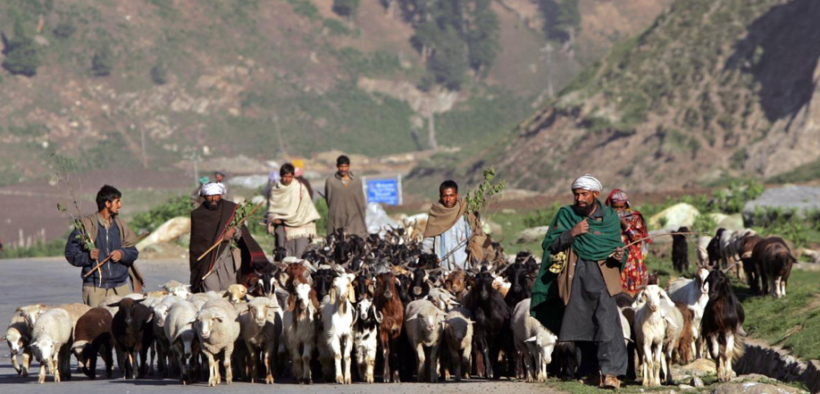एम्स अध्ययन: कश्मीरी जनजातियों में ग़ैर-संक्रामक रोगों की अधिकता

अखिल भारतीय आयुर्विज्ञान संस्थान, नई दिल्ली के शोधकर्ताओं के समूह द्वारा किए गए एक अध्ययन से पता चला कि जम्मू और कश्मीर की जनजातीय या ट्राइबल आबादी में उच्च रक्तचाप, हृदयाघात और गुर्दे ख़राब होने जैसे ग़ैर-संक्रामक रोग होने की अधिक आशंका पाई गई है।
श्रीनगर के शेर-इ-कश्मीर चिकित्सा विज्ञान संस्थान के साथ मिलकर कश्मीर के दो सुविधाहीन जनजातीय समुदायों गुज्जर और बकरवाल पर ये अध्ययन किया गया था।
शोधकर्ताओं ने पाया कि 22.5 प्रतिशत पुरुषों और 20.6 प्रतिशत महिलाओं में बढ़ता रक्तचाप या हाइपरटेंशन से पहले के लक्षण हैं।
अध्ययन के प्रधान शोधकर्ता डॉ. मोहम्मद अशरफ़ गनी ने बताया कि शोध में सामने आया ये स्तर बहुत अधिक है क्योंकि हाइपरटेंशन के मरीज़ों का राष्ट्रीय औसत पुरुषों में 13.8 प्रतिशत और महिलाओं में 8.8 प्रतिशत है। बहुत मुमकिन है कि हाइपरटेंशन के लक्षण का पता चलने पर अगर समय पर इलाज ना किया जाए तो ये पूरी तरह हाइपरटेंशन रोग बन जाता है।
डॉ. गनी ने द हेल्थ को बताया कि हाइपरटेंशन की वजह से लोगों में गुर्दे ख़राब होने, दिल का दौरा पड़ने या फिर हृदयाघात का ख़तरा पैदा होता है। ये जनजातियाँ ऊँचाई पर रहती हैं। ऊँचाई की वजह से उच्च रक्तदाब होता है। उन के भोजन और चाय में नमक भी अधिक मात्रा में डाला जाता है। अधिक नमक खाने का भी उच्च रक्तचाप से सीधा संबंध है। उन के हाइपरटेंशन के शिकार होने के अन्य कारणों को जानने के लिए भी हम और अध्ययन कर रहे हैं।
भारत में जनजातियों की सेहत से जुड़े तथ्य
भारत सरकार के स्वास्थ्य व परिवार कल्याण मंत्रालय और जनजातीय मामलों के मंत्रालय ने 2018 में अपना शोध जारी किया था जो कि भारत में जनजातियों की स्वास्थ्य देखभाल पर आधारित था।
इस अध्ययन में जनजातीय स्वास्थ्य के अन्य विशेषज्ञों के साथ सर्च (सामुदायिक स्वास्थ्य में शिक्षा, कार्य और शोध) के संस्थापक डॉ. अभय बंग भी शामिल थे जो कि इसके अध्यक्ष थे।
जनजातीय स्वास्थ्य से जुड़ी रिपोर्ट से चिंताजनक तथ्य पता चलते हैं। भारत में 104 मिलियन से ज़्यादा क़बीलाई या जनजातीय लोग रहते हैं।
नब्बे प्रतिशत से अधिक जनजातीय लोग ग्राणीण क्षेत्रों में रहते हैं। ग़ैर अनुसूचित जनजातीय आबादी में 28.5 प्रतिशत के मुक़ाबले जनजातीय आबादी में केवल 10.7 प्रतिशत को ही नल का पानी उपलब्ध है।
रिपोर्ट के अनुसार जनजातियों में हर चार में से एक वयस्क को हाइपरटेंशन है। काम ना करने, शराब पीने, तंबाकू आदि खाने और उम्र के साथ हाइपरटेंशन तेज़ी से बढ़ा है।
लेकिन अभी भी हर तीन में से दो क़बीलाई पुरुषों और महिलाओं को इस रोग तथा इस के लक्षणों के बारे में जानकारी नहीं है। इस से भी अधिक चिंता की बात ये है कि हाइपरटेंशन से पीड़ित सिर्फ़ पाँच प्रतिशत पुरुषों और 9 प्रतिशत महिलाओं को ही पता है कि उन्हें ये समस्या है।
जनजातीय आबादी द्वारा स्वास्थ्य सुविधाएँ पाने में बाधाएँ:
डॉ. गनी ने बताया कि इन जनजातियों को बेहतर स्वास्थ्य देखभाल सुविधाएँ उपलब्ध करवाने में सामाजिक, धार्मिक और दूरी संबंधी चुनौतियाँ हैं। इन में से बहुत से लोग हाइपरटेंशन की दवाएँ नहीं लेते हैं और इलाज का पुराना तरीक़ा ही अपनाते हैं। इन लोगों का ये भी मानना है कि इस तरह की बीमारियाँ धार्मिक कारणों की वजह से होती हैं। कुछ हकीम भी अपने फ़ायदे के लिए इन लोगों को गुमराह करते हैं। परिवहन लागत और अन्य कारणों की वजह से दवाएँ यहाँ शहरों के मुक़ाबले तीन गुनी महँगी हैं।
स्वास्थ्य मंत्रालय की ट्राइबल स्वास्थ्य देखभाल रिपोर्ट के अनुसार ग्रामीण स्वास्थ्य सांखि्यकी से पता चलता है कि सामाजिक-आर्थिक और गंभीर भौगोलिक चुनौतियों की वजह से क़बीलाई इलाक़ों में संसाधनों और स्वास्थ्य अवसंरचना की भारी कमी है।
सड़कें या ख़राब हैं या फिर बहुत कम हैं इसलिए स्वास्थ्य सेवाओं तक पहुँच मुश्किल हो जाती है। स्वास्थ्य कर्मियों की कमी, उपकरणों की कमी, भाषा और सामाजिक बाधाएँ, स्वास्थ्य केन्द्रों में बहुत देर तक इंतज़ार करने और ग़रीबी की वजह से स्वास्थ्य देखभाल पाने में और भी समस्याएं आती हैं।
रिपोर्ट में ये भी बताया गया है कि देश की जनजातीय आबादी रोगों का तीन गुना बोझ उठा रही है। मलेरिया और तपेदिक जैसे संक्रामक रोग और कुपोषण जहाँ लगातार बढ़ते जा रहे हैं वहीं तेज़ी से होने वाले शहरीकरण, पर्यावरण से जुड़ी समस्याओं और बदलती जीवनशैली की वजह से कैंसर, हाइपरटेंशन और मधुमेह जैसे ग़ैर-संक्रामक रोगों की आशंका और भी बढ़ गई है।

















